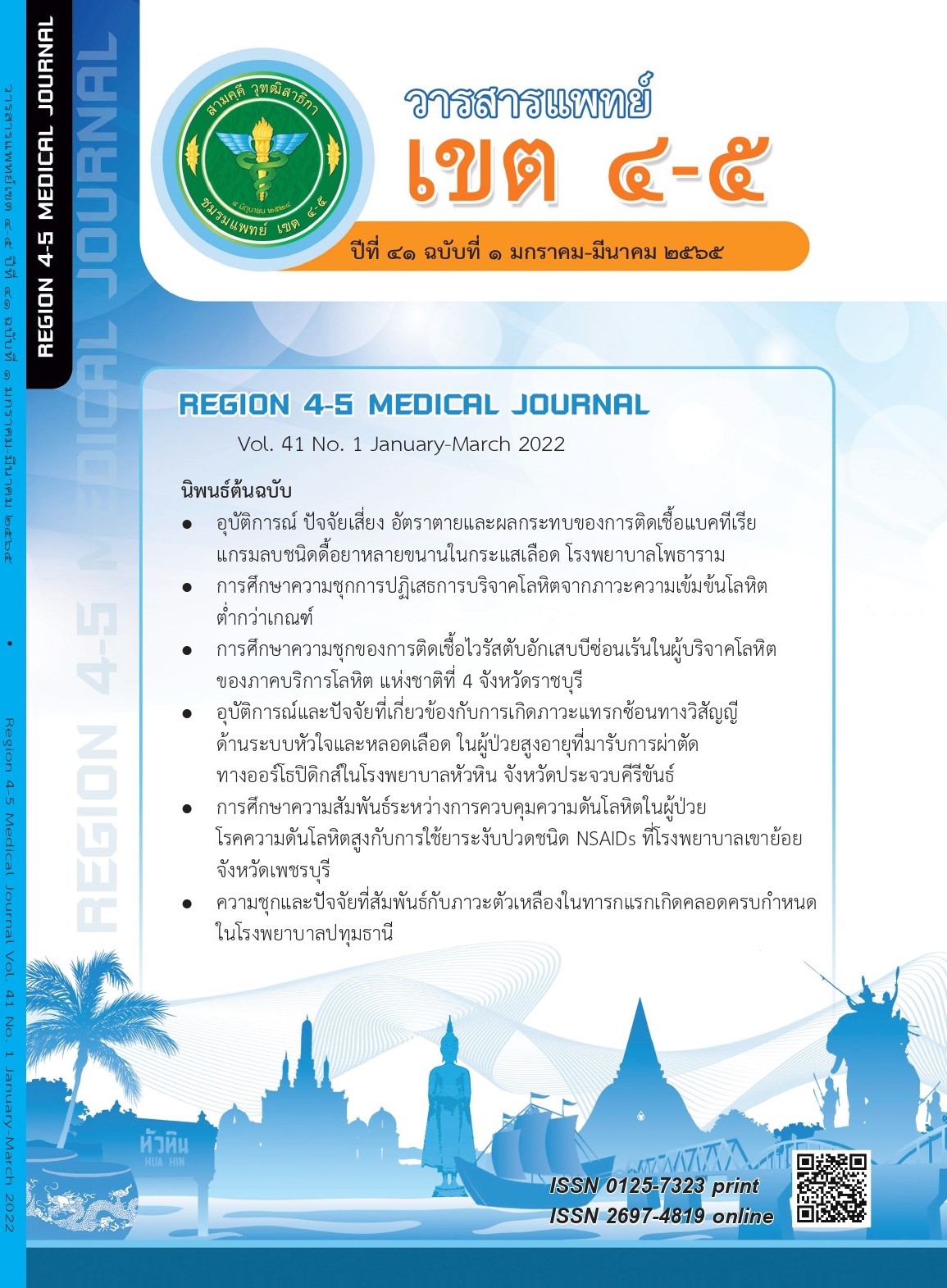ผลของระดับดัชนีมวลกายต่อการให้ยาเคมีบำบัด และอาการข้างเคียงจากยาเคมีบำบัดในผู้ป่วยมะเร็งเนื้อตันของโรงพยาบาลนครปฐม
คำสำคัญ:
ดัชนีมวลกาย, โรคมะเร็ง, ยาเคมีบำบัดบทคัดย่อ
วัตถุประสงค์: เพื่อศึกษาถึงผลจากระดับของดัชนีมวลกาย 3 กลุ่ม คือ ระดับดัชนีมวลกายน้อยกว่า 18.5, ระดับดัชนีมวลกาย 18.5 – 24.9 และระดับดัชนีมวลกายมากกว่าหรือเท่ากับ 25 ที่มีต่อการเลื่อนการให้ยาเคมีบำบัด การลดปริมาณยาเคมีบำบัด และผลข้างเคียงจากยาเคมีบำบัด ในผู้ป่วยมะเร็งเนื้อตันที่โรงพยาบาลนครปฐม
วิธีการศึกษา: เป็นการศึกษาย้อนหลัง โดยผู้วิจัยทำการเก็บข้อมูลจากเวชระเบียนของผู้ป่วยมะเร็งเนื้อตัน ได้แก่ มะเร็งเต้านม มะเร็งปอดและมะเร็งลำไส้ใหญ่ ที่มารับยาเคมีบำบัดสูตรต่าง ๆ ที่โรงพยาบาลนครปฐมในระหว่างวันที่ 1 มิถุนายน 2563ถึง 31 ธันวาคม 2563
ผลการศึกษา: ในผู้ป่วยทั้งหมดจำนวน 246 ราย มีผู้ป่วย 90 รายที่อยู่ในกลุ่มที่มีระดับดัชนีมวลกายน้อยกว่า 18.5 คิดเป็นร้อยละ 36.6 ผู้ป่วยกลุ่มที่มีระดับดัชนีมวลกาย 18.5 – 24.99 และผู้ป่วยกลุ่มที่มีระดับดัชนีมวลกายมากกว่าหรือเท่ากับ 25 มีจำนวน 115 และ 41 ราย คิดเป็นร้อยละ 46.7 และ 16.7 ตามลำดับ พบว่าในกลุ่มผู้ป่วยกลุ่มที่มีระดับดัชนีมวลกายน้อยกว่า 18.5 มีผู้ป่วยที่ถูกลดขนาดยาเคมีบำบัด, เกิดภาวะ neutropenia, เกิดภาวะ anorexia, เกิดภาวะน้ำหนัก, เกิดภาวะ fatigue, และเกิดภาวะ febrile neutropenia มากกว่าผู้ป่วยกลุ่มอื่น ๆ อย่างมีนัยยะสำคัญทางสถิติผลจากการวิเคราะห์ข้อมูลด้วยวิธี multivariate analysis พบว่าปัญหาที่สัมพันธ์กับภาวะระดับดัชนีมวลกายต่ำกว่า 18.5 หลังได้รับยาเคมีบำบัด คือ ภาวะ neutropenia (OR 2.870, 95% CI 1.339–6.152, p .007) และ ภาวะ anorexia (OR 2.297 95% CI 1.020–5.175, p .045)
สรุป: ระดับดัชนีมวลกายนั้นมีผลต่อการให้ยาเคมีบำบัดและการเกิดอาการข้างเคียงจากยาเคมีบำบัด เนื่องจากผู้ป่วยกลุ่มที่มีระดับดัชนีมวลกายต่ำมีการลดปริมาณยาเคมีบำบัด และมีอาการข้างเคียงจากยาเคมีบำบัดมากขึ้น ดังนั้นการประเมินระดับดัชนีมวลกาย และการให้โภชนบำบัดแก่ผู้ป่วย ตั้งแต่ก่อนเริ่มให้ยาเคมีบำบัด จึงมีความสำคัญอย่างยิ่ง เพื่อป้องกันการเกิดอาการไม่พึงประสงค์ต่าง ๆ ที่จะเกิดขึ้น และช่วยให้ผู้ป่วยได้รับยาเคมีบำบัดครบตามแผนการรักษา
เอกสารอ้างอิง
Fearon K, Strasser F, Anker SD, et al. Definition and classification of cancer cachexia: An international consensus. Lancet Oncol. 2011;12:489–495.
Thoresen L, Frykholm G, Lydersen S, et al. Nutritional status, cachexia and survival in patients with advanced colorectal carcinoma. Different assessment criteria for nutritional status provide unequal results. Clin Nutr. 2013;32(1):65–72.
Laviano A, Meguid MM. Nutritional issues in cancer management. Nutrition. 1996;12(5):358–371.
Bruggeman AR, Kamal AH, LeBlanc TW, et al. Cancer Cachexia: Beyond Weight Loss. J Oncol Pract. 2016;12(11):1163–71.
Baracos VE. Management of muscle wasting in cancer-associated cachexia: understanding gained from experimental studies. Cancer. 2001;92(6Suppl):1669–77.
Baracos VE. Cancer-associated cachexia and underlying biological mechanisms. Annu Rev Nutr. 2006; 26:435–61.
National Comprehensive Cancer Network. Antiemesis. Plymouth Meeting: National Comprehensive Cancer Network; 2020.
Bozzetti F. Basics in Clinical Nutrition: Nutritional support in cancer. e-SPEN 2010:e148–52.
Caillet P, Liuu E, Simon AR, et al.Association between cachexia, chemotherapy and outcomes in older cancer patients: A systematic review. Clin Nutr. 2017;36(6):1473–82.
Caro MMM, Laviano A, Pichard C, et al. Nutritional intervention and quality of life in adult oncology patients. Clin Nutr. 2007;26(3):289–301.
Pin F, Couch ME, Bonetto A, et al. Preservation of muscle mass as a strategy to reduce the toxic effects of cancer chemotherapy on body composition.Curr Opin Support Palliat Care. 2018;12(4):420–426.
Takeda T, Sasaki T , Suzumori C. The impact of cachexia and sarcopenia in elderly pancreatic cancer patients receiving palliative chemotherapy. Int J Clin Oncol. 2021;26(7):1293–1303.
Dev R. Measuring cachexia-diagnostic criteria. Ann Palliat Med. 2019;8(1):24–32.
Grabowski JP, Richter R, Rittmeister H, et al. Impact of Body Mass Index (BMI) on Chemotherapy-associated Toxicity in Ovarian Cancer Patients. A Pooled Analysis of the North-Eastern German Society of Gynecological Oncology (NOGGO) Databank on 1,213 Patients. Anticancer Res. 2018;38(10):5853–8.
Saleh K, Carton M, Dieras V, et al. Impact of body mass index on overall survival in patients with metastatic breast cancer. Breast. 2021;55:16–24.
Shepshelovich D,Xu W, Lu L, et al. Body Mass Index (BMI), BMI Change, and Overall Survival in Patients With SCLC and NSCLC: A Pooled Analysis of the International Lung Cancer Consortium. J Thorac Oncol.2019;14(9):1594–1607.
Shahjehan F, Merchea A, Cochuyt J, et al. Body Mass Index and Long-Term Outcomes in Patients With Colorectal Cancer. Front Oncol. 2018;8:620.
Cha B, YU JH, Jin YJ, et al. Survival Outcomes According to Body Mass Index in Hepatocellular Carcinoma Patient: Analysis of Nationwide Cancer Registry Database.Sci Rep. 2020;10:8347.
Greenlee H, Unger JM, Hershman DL, et al. Association between Body Mass Index and Cancer Survival in a Pooled Analysis of 22 Clinical Trials. Cancer Epidemiol Biomarkers Prev. 2017;26(1):21–29.
Medical Dictionary Regulatory Activities. Common terminology criteria for adverse events (CTCAE) Washington, D.C.: U.S. Department of Health and Human Services; 2017.
Fearon K, Arends J, Baracos V. Understading the mechanisms and treatment options in cancer cachexia. Nat Rev Clin Oncol. 2013;10(2):90–9.
Martin L, Senesse P, Gioulbasanis T, et al. Diagnostic criteria for the classification of cancer-associated weight loss. J Clin Oncol. 2015;33(1):90–9.
ดาวน์โหลด
เผยแพร่แล้ว
รูปแบบการอ้างอิง
ฉบับ
ประเภทบทความ
สัญญาอนุญาต

อนุญาตภายใต้เงื่อนไข Creative Commons Attribution-NonCommercial-NoDerivatives 4.0 International License.
ลิขสิทธิ์บทความเป็นของผู้เขียนบทความ แต่หากผลงานของท่านได้รับการพิจารณาตีพิมพ์ลงวารสารแพทย์เขต 4-5 จะคงไว้ซึ่งสิทธิ์ในการตีพิมพ์ครั้งแรกด้วยเหตุที่บทความจะปรากฎในวารสารที่เข้าถึงได้ จึงอนุญาตให้นำบทความในวารสารไปใช้ประโยชน์ได้ในเชิงวิชาการโดยจำเป็นต้องมีการอ้างอิงถึงชื่อวารสารอย่างถูกต้อง แต่ไม่อนุญาตให้นำไปใช้ในเชิงพาณิชย์




